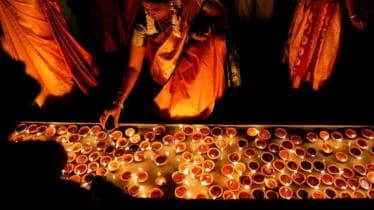With 28 states, eight Union territories, hundreds of cities, and cultures spanning thousands of years, India is in no way a homogenous country. So, it’s no surprise that even Diwali isn’t just the festival of lights but so much more for different people in different parts of the country.
For instance, in Punjab (and for Sikhs everywhere), Diwali coincides with Bandi Chhor Diwas. The day marks the return of sixth Sikh guru – Guru Hargobind – to Amritsar after having liberated 52 prisoners from the Gwalior fort who were being held captive by Mughal ruler Jahangir. The story dates back to the 17th century, when Guru Hargobind stepped up as the leader of Sikhs soon after Guru Arjan Dev, his father, was executed by Jahangir for strengthening the Sikh faith among people in 1606.
The tale goes that when Jahangir fell ill, Guru Hargobind, based on the claims of court astrologers, was directed by the Mughal ruler to surrender himself at the Gwalior Fort and pray for the emperor’s health or be executed. Though the Guru complied, he was kept captive even after Jahangir recovered and until one of his followers convinced the ruler to free him.
However, Guru Hargobind insisted that 52 other prisoners (who were Rajput princes and kings) in the fort be freed with him, which Jahangir granted. Thus, the Guru came to be known as the “liberator of the imprisoned” and Sikhs have celebrated the day ever since.
Gurjeet Kaur, a 52-year-old Lucknow-based makeup artist, tells FE, “The day that Guru Hargobind returned to Golden Temple after having freed the prisoners, Diwali was being celebrated everywhere. For Sikhs, every year since then, we’ve marked Bandi Chhor Diwas on the same day. We prepare bhog and prasad, and gurdwaras prepare langar where anyone and everyone is welcome. All Sikhs light lamps and diyas at their homes, in gurdwaras, and at the Golden Temple too.”
In the Awadh region of Uttar Pradesh, the day after Diwali is celebrated as Jamghat. While the literal translation of the word means a gathering, Jamghat is a kite-flying festival where the celebration is relaxed, and at the same time, very competitive. It is said to have originated and spread due to the love the nawabs of Lucknow had for kite-flying, and known for being a true symbol of communal harmony in Awadh.
In Bengal, the eve of Diwali is celebrated as Kali Pujo. The myths about its origins are many, but the most widely believed one dates back to the 16th century when Tantric scholar Krishnananda Agamavagisha dreamt that goddess Kali has asked him to worship her in all her “feminine divinity.” Agamavagisha has since been credited with kicking off the celebration of Kali Pujo.
Sannidhya Sen, a student from Durgapur, says there’s another origin story about Kali Pujo. He shares, “Initially, Kali Pujo was only celebrated by dacoits and bandits to please Kali, their patron goddess. Like her, the dacoits would wear necklaces made of skulls and bones. It slowly began being celebrated in villages and small towns, and was adopted by cities much later. Barasat, a small town near Kolkata celebrates Kali Pujo in an even grander fashion than Durga Pujo. It is after all, like Diwali, a festival that signifies the win of good over evil.”
In Tamil Nadu, the main celebrations take place one day before Diwali. The day is celebrated as Narak Chaturdashi to mark the killing of the demon Bhoumasur or Narakasur by the Hindu god Krishna. According to mythology, Bhoumasur was the ruler of Pragjyotishpur and used his power to trouble gods and his subjects, and Krishna killed him to save the people living under his reign. But even in different places in Tamil Nadu, the festivities aren’t uniform. Vijaya Swaminathan, a 55-year-old from Chennai, tells FE that while her family celebrates Diwali on the day of the festival, all their rituals are done in the morning itself.
“We celebrate Diwali before the sun rises. We perform a Ganga snanam ritual where we add a drop of water from the river Ganga into our bucket since we can’t take a dip in the river itself. We don’t have any prayer rituals per se, but we do go to the temple right after the bath to pray for a healthy life,” says Swaminathan.
Across religions and regions, there are different deities who are revered on Diwali. For instance, Jains celebrate Diwali as the end of the year and as the completion of Lord Mahavira’s spiritual journey.
The tribal communities living in and around the rural areas of Bastar in Chhattisgarh celebrate Devari or Diyari. This tradition has two ways of celebrations and two meanings attached to them. In the morning, people worship their cattle and the new crop that feeds them throughout the year. At night, another celebration begins – that of the first marriage that took place in the Gond tribe – of Ishar and Gaura. People take out processions, dance, sing, and have a feast.
This reverence for animals isn’t limited to Chhattisgarh though. During the week of Diwali, Sikkim celebrates the five-day-long festival of Tihar. On the very first day, known as Kaag Tihar, crows are worshipped, followed by Kukkar Tihar for the reverence of dogs, and Gai Tihar where cows are worshipped, garlanded, and given a feast of foods. On the same day as Gai Tihar, folk songs called Deusi and Bhailo are sung, and Laxmi Puja takes place as well.
Truly a nation of unity in diversity!
